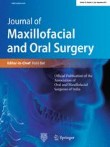- Joined
- Nov 20, 2019
- Messages
- 802
- Time Online
- 7m 51s
- Reputation
- 2,763
The cervicomental angle (or submental-cervical angle) is the angle formed by 2 lines from the chin and sternal notch that meet at the hyoid bone.

Ideally the cervicomental angle should be between 90 and 120 degrees, anything higher than that is considered blunted and obtuse.
The lower the angle (within the 90º - 120º range), the better.

 link.springer.com
link.springer.com
The submental-cervical angle of the idealized profile image was altered in 5° increments from 90° to 130°, in order to represent variations in the angle and morphology of this region (Fig.1).

Observers
Based on the results of a pilot study and power calculation, 185 observers took part in the study, separated into three groups (pre-treatment orthognathic patients, laypeople and clinicians; Table1), with the following selection criteria:

Questionnaire
Each observer was given a questionnaire and asked to provide the following information: age, gender, ethnic origin, how would you rate the attractiveness of your facial appearance, and how important do you think it is to have an attractive facial appearance. An instruction sheet accompanied the questionnaire, asking the observers to rate each image in terms of facial attractiveness using the following rating scale:
Perceived Attractiveness of Images
Table 3 indicates the median attractiveness rating of the observers on a Likert scale from 1 to 7, where 1 indicates ‘extremely unattractive’ and 7 indicates ‘extremely attractive’

Most Attractive and Least Attractive Images
Table 4 demonstrates the data in rank order from most to least attractive, sorted on the basis of responses from the clinician group. The rank ordering observed in the clinician group from most attractive to least attractive is also seen in the patient and lay people groups.

Conclusions
The results of the present investigation demonstrate that a submental-cervical angle of 90°–105° is deemed acceptable. Angles above this value begin to be perceived as unattractive, though up to 120° is deemed only slightly unattractive by the lay and clinician groups, but very unattractive by the patient group. By 125°–130° all groups perceive the submental-cervical angle as very/extremely unattractive.
The cervicomental angle is very important as it affects how the rest of the face is perceived:

Things that contribute to the appearance of a suboptimal cervicomental angle are:
Ideally the cervicomental angle should be between 90 and 120 degrees, anything higher than that is considered blunted and obtuse.
The lower the angle (within the 90º - 120º range), the better.

Submental-Cervical Angle: Perceived Attractiveness and Threshold Values of Desire for Surgery
The submental-cervical angle may alter as a result of mandibular orthognathic surgery and/or the ageing process and is therefore an important facial aesthetic parameter for comparative diagnosis and treatment planning. The purpose of this study was to undertake a quantitative evaluation of the...
The submental-cervical angle of the idealized profile image was altered in 5° increments from 90° to 130°, in order to represent variations in the angle and morphology of this region (Fig.1).
Fig. 1 Submental-cervical angle of the idealized profile image was altered in 5° increments from 90° to 130°
Observers
Based on the results of a pilot study and power calculation, 185 observers took part in the study, separated into three groups (pre-treatment orthognathic patients, laypeople and clinicians; Table1), with the following selection criteria:
- Orthognathic patients pretreatment (only 1 consultation appointment); primary concern was facial appearance; no previous orthodontic or facial surgical treatment; no history of facial trauma; no severe psychological issues, e.g. body dysmorphic disorder.
- Laypeople no previous orthodontic or facial surgical treatment; no facial deformities; no history of facial trauma.
- Clinicians involved in the management of patients with facial deformities. This group included 19 clinicians in oral and maxillofacial surgery and 16 orthodontists, with 1–16 years of experience in the clinical management of patients requiring orthognathic surgery.
Questionnaire
Each observer was given a questionnaire and asked to provide the following information: age, gender, ethnic origin, how would you rate the attractiveness of your facial appearance, and how important do you think it is to have an attractive facial appearance. An instruction sheet accompanied the questionnaire, asking the observers to rate each image in terms of facial attractiveness using the following rating scale:
- Extremely unattractive.
- Very unattractive.
- Slightly unattractive.
- Neither attractive nor unattractive.
- Slightly attractive.
- Very attractive.
- Extremely attractive.
Perceived Attractiveness of Images
Table 3 indicates the median attractiveness rating of the observers on a Likert scale from 1 to 7, where 1 indicates ‘extremely unattractive’ and 7 indicates ‘extremely attractive’
Most Attractive and Least Attractive Images
Table 4 demonstrates the data in rank order from most to least attractive, sorted on the basis of responses from the clinician group. The rank ordering observed in the clinician group from most attractive to least attractive is also seen in the patient and lay people groups.
Conclusions
The results of the present investigation demonstrate that a submental-cervical angle of 90°–105° is deemed acceptable. Angles above this value begin to be perceived as unattractive, though up to 120° is deemed only slightly unattractive by the lay and clinician groups, but very unattractive by the patient group. By 125°–130° all groups perceive the submental-cervical angle as very/extremely unattractive.
The cervicomental angle is very important as it affects how the rest of the face is perceived:
Figure 21.22 Identical facial profiles varying only in the submental-cervical contour; the submental-cervical contour may influence the perceived aesthetics of the other facial prominences (forehead, nose, lips and chin).
Things that contribute to the appearance of a suboptimal cervicomental angle are:
- Excess of fat on the submental area
- Redundant skin on the submental area
- Short submental length
This may be due to a recessed chin (microgenia) and/or mandible (retrognathia) - Low and/or forward hyoid bone position
- Lax platysma muscles
- Large submandibular glands
